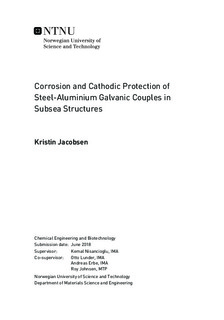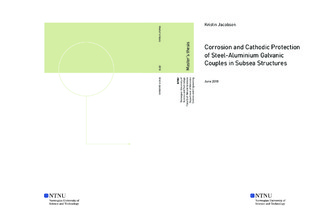| dc.description.abstract | An increasing interest for use of aluminium in subsea structures has been seen the resent years, considering replacing some of the heavier steel components with aluminium. Due to good corrosion resistance and strength to weight ratio the aluminium alloys of the 5000-series and 6000-series are of great relevance. Galvanic corrosion and crevice corrosion must be taken into consideration when replacing the more noble steel with aluminium. Cathodic protection of steel is widely used in seawater structures, and the possibility of protecting both steel and aluminium in galvanic couples is therefore of interest.
The aim of the thesis was to investigate whether or not steel-aluminium galvanic couples could be protected against crevice corrosion by applied cathodic protection. Samples of carbon steel X65 and the aluminium alloys 5083 and 6082 were galvanic coupled in a simulated crevice with applied CP by the sacrificial anode AlZnIn. The experiments were performed in artificial seawater at 10C with exposure time up to twenty days. The affect of crevice sizes of 100 micro meter and 300 micro meter was studied. In addition, galvanic couples of carbon steel X65 and the aluminium alloys 5083, 6005 and 6082 in absence of a crevice were studied to validate the effect of cathodic protection. Open Circuit tests were also performed. Weight loss measurements and surface characterization by SEM and EDS were performed to examine corrosion rates and the formation of deposits.
Cathodic protection of the galvanic couples was possible in the absence of a crevice, where cathodic currents were seen on both steel and the aluminium alloys. The currents on steel were one and two orders of magnitude larger than on Al. Galvanic couples in a simulated crevice with size of 300 micro meter showed anodic currents on Al, though cathodic currents were seen on steel. A uniform calcareous deposit layer mainly of Mg(OH)_2 was seen on steel with precipitation of Ca-ions near the steel surface. A thin protective oxide layer was observed on Al. In galvanic couples with a crevice of 100 micro meter the aluminium alloys showed initial anodic peak currents which steadily decayed towards zero. The corrosion rates increased as a function of exposure time, and localized corrosion was mainly seen at the crevice mouth on Al. Higher initial cathodic currents were seen on steel which decreased steadily. Reduction reactions on steel increased the pH in the crevice and the oxide film on Al was destabilized. Intermetallic cathodic sites in the Al-matrix were detached due to alkaline etching. Oxygen depletion in the crevice and the formation of calcareous deposits and renewed oxide films stabilized the currents and the corrosion attacks on the alloys with time. Nevertheless, steel-aluminium galvanic couples could be protected in the form of corrosion control against crevice corrosion with applied cathodic protection. | |

